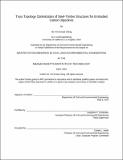Truss topology optimization of steel-timber structures for embodied carbon objectives
Author(s)
Ching, Ho Yin Ernest.
Download1191840757-MIT.pdf (1.535Mb)
Other Contributors
Massachusetts Institute of Technology. Department of Civil and Environmental Engineering.
Advisor
Josephine V. Carstensen.
Terms of use
Metadata
Show full item recordAbstract
Topology optimization in structural design is still a relatively new tool. Most existing research on truss and frame structures focuses on single material applications, and the developments of ground structure-based topology optimization in multi-material structures are limited. This research presents a truss topology optimization algorithm that designs with a mix of glue-laminated timber (GLT) and steel elements. The motivation behind allowing the choice of both these materials is to utilize the strengths of each material in both tension and compression. In addition, this work seeks to include environmental consideration, by incorporating in the algorithm that timber has a smaller embodied carbon coefficient (ECC) compared to steel. This work uses the ground structure approach to truss topology optimization and designs are generated and compared using (i) a minimum compliance and (ii) a stress-constrained algorithm. The algorithms are constructed such that both the area and a choice of material is made for each element in the ground structure. Both frameworks use fmincon in MATLAB as the gradient-based optimizer. The Solid Isotropic Material with Penalization (SIMP) interpolation is used to relate elastic modulus and embodied carbon for two materials with respect to normalized density variables. To demonstrate the versatility of this design methodology, designs obtained from different objectives and different constraints are presented and compared. We find that, for minimum compliance objectives, the weight-constrained problem produced all-steel truss solutions, while global warming potential (GWP)-constrained problem produced all-timber truss solutions. These results align with our expectations based on material stiffness properties. For the stress-constrained problem with minimum GWP objectives, the solutions obtained from two modeling assumptions were compared: (i) with real material stress constraints and (ii) with modified stress constraints, where timber was considered as a compression-only material and steel as a tension-only material. Surprisingly, we find that the solutions obtained with the real stress limits are more polluting than the modified stress limit solutions. While the modified stress solutions placed steel in tension and timber in compression for the most environmentally friendly design, the real stress solutions generally favored steel over timber. This is believed to be caused by the nonlinearities introduced through the SIMP interpolation.
Description
Thesis: M. Eng., Massachusetts Institute of Technology, Department of Civil and Environmental Engineering, May, 2020 Cataloged from the official PDF of thesis. Includes bibliographical references (pages 41-43).
Date issued
2020Department
Massachusetts Institute of Technology. Department of Civil and Environmental EngineeringPublisher
Massachusetts Institute of Technology
Keywords
Civil and Environmental Engineering.